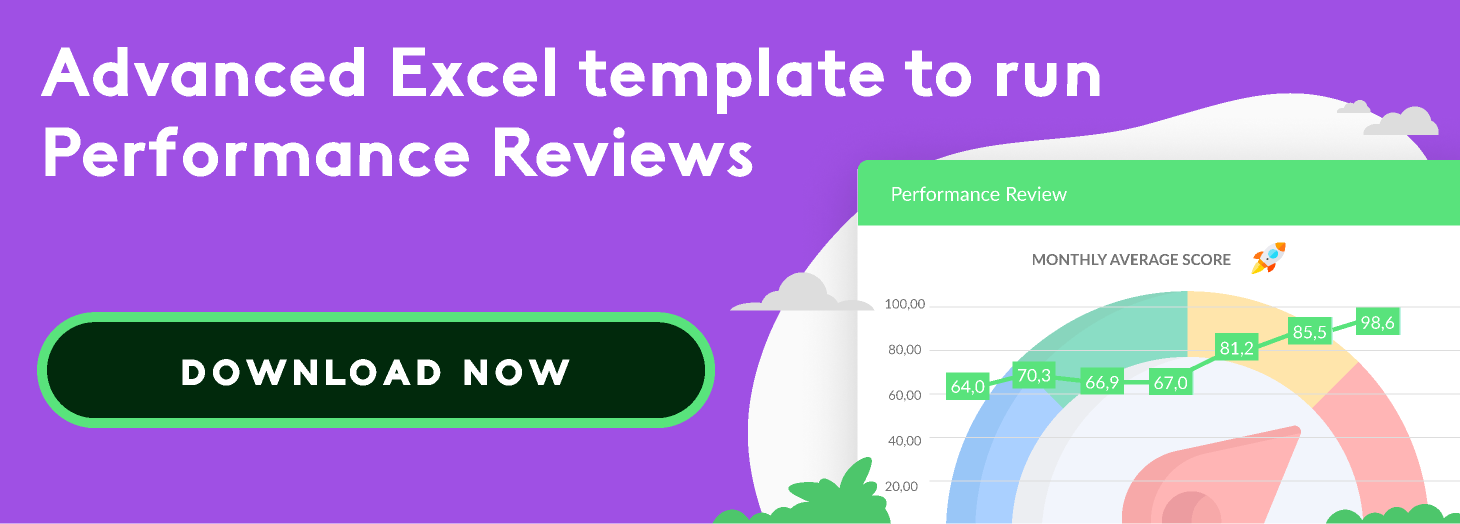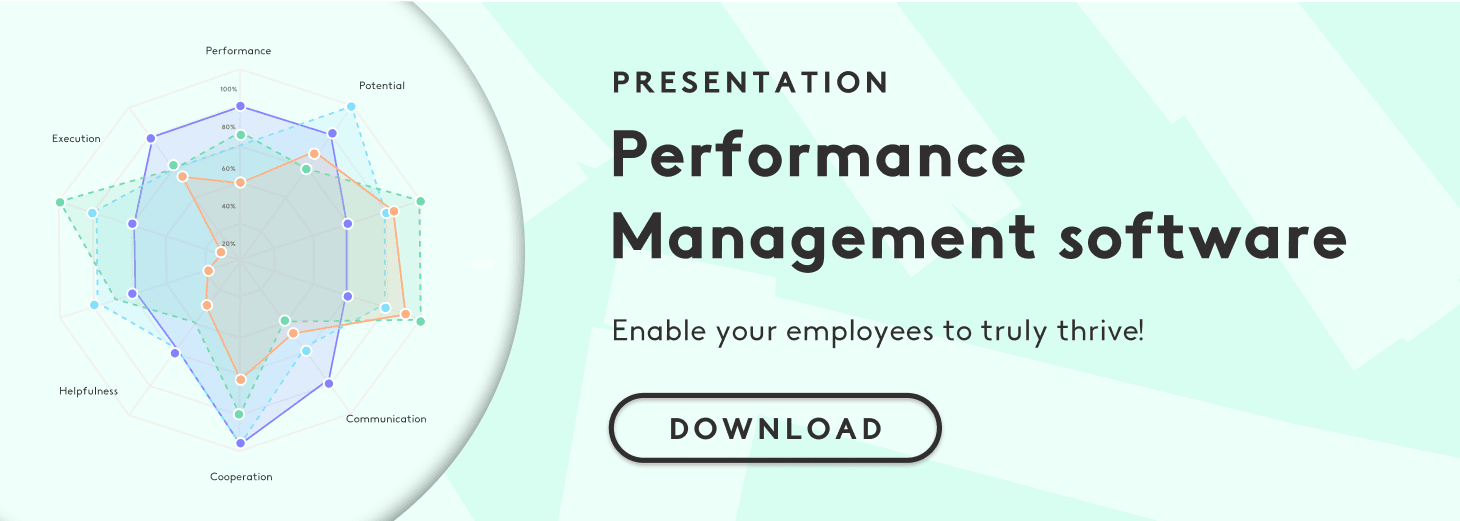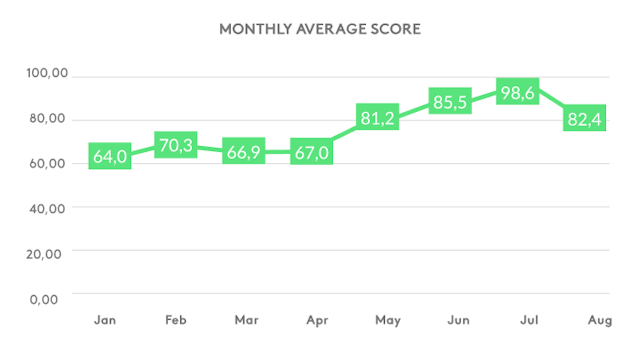The performance appraisal has become a strategic tool in companies. It’s good for employees as it gives them the chance to identify their strengths and weaknesses and to grow as a professional. And naturally, the organisation gets the information it needs to better manage its human capital and meet its objectives as a result.
It’s a complex process that requires a clear methodology and minimal resources. But it’s worth the effort as it enables you to make the most of the organisation’s main resource: people.
We’d like to begin this guide with this tongue-in-cheek comic sketch that exposes where most performance appraisals usually fail. The answer is simple.
- Clear-cut next steps and follow-up sessions were not defined between one appraisal and the next.
- Expectations between reviewer and employee were not defined.
- Communication between them was poor and vague.
What is a performance appraisal?
In the book "La gestión de Recursos Humanos" (Human resources management, 2007) by S. L. Dolan, R. Valle Cabrera, S. E. Jackson and R.S. Schuler, the performance review is defined as: "a structural and systematic procedure to measure, assess and influence the attributes, behaviour and results related to work, with the aim of discovering how productive an employee is, and if their future performance could be improved."
On the other hand, I. Gil, L. Ruiz and J. Ruiz take a more human approach in the book "La nueva dirección de personas en la empresa" (The new direction of people in the company, 1997), in this definition:
"The appraisal is a tool that serves the people, with a more responsible approach to their work and the company, towards the optimisation of resources. It’s also a technique for systematically clarifying, as objectively as possible, someone’s performance over a certain period of time, in relation to their current tole and personal characteristics, as well as their contribution to set objectives."
It can, therefore, be summarised as the systematic process of measuring and assessing, as objectively as possible, an employee’s work over a period of time and how much they have contributed to the company’s goals.
When conducting a performance appraisal, it’s essential to carry out a series of actions that focus on getting the necessary feedback to assess the employee. This chart shows the steps that are followed in a standard process:
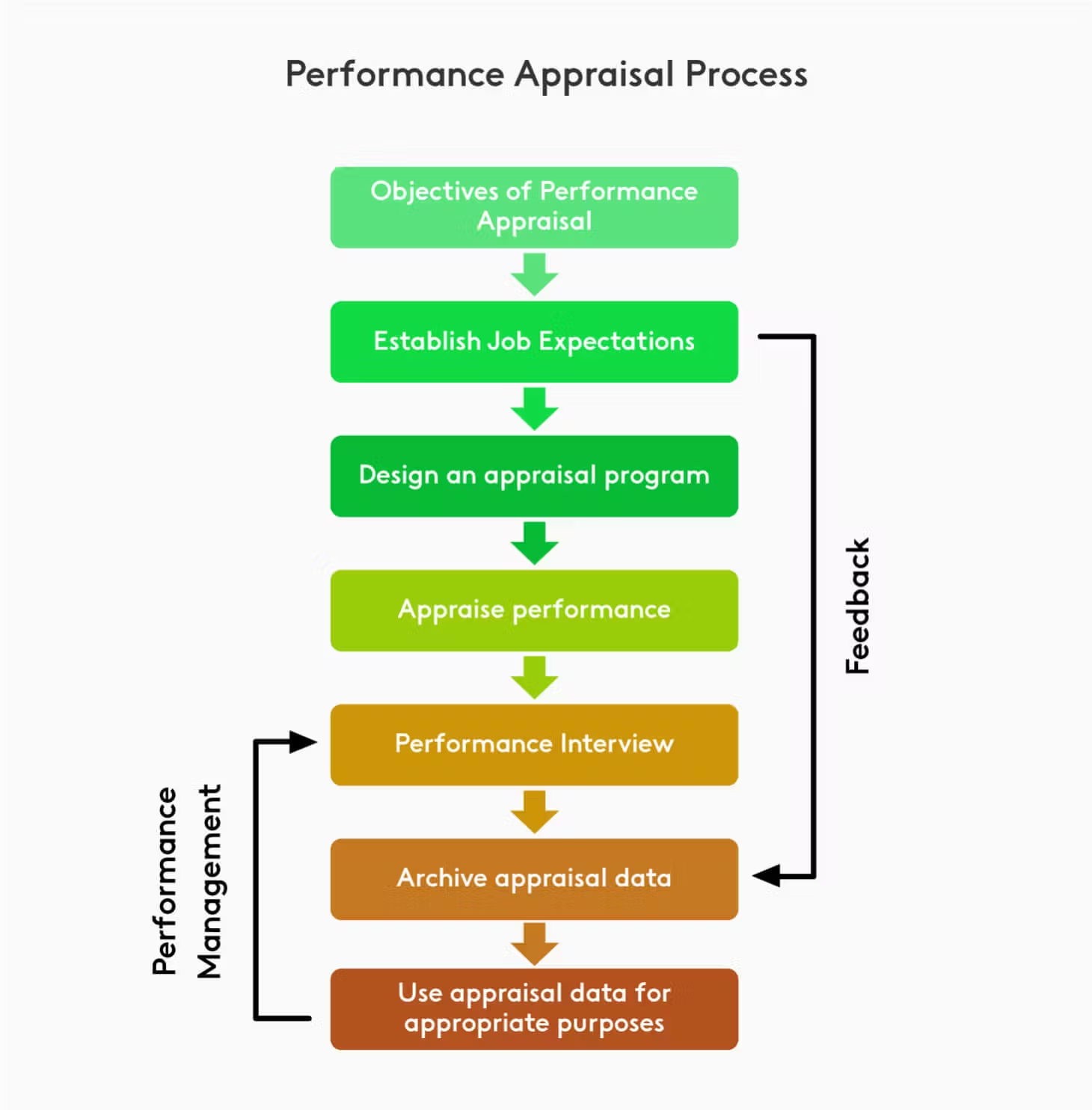
Why is a performance appraisal useful?
The main aim of measuring employee performance is to assess and help them improve their performance and increase their potential, as well as the value they can bring to the company in the future. Even so, there are other objectives such as providing feedback, improving communication, understanding employees’ needs, etc. Let’s look at them one by one:
Offer feedback: give the employee objective information about their work over the last few months, as well as convey the company’s expectations.
Decide on promotions: the appraisal process gives us objective data for making decisions about who is ready to take on new responsibilities.
Decide on dismissals: when you have to reduce the team, the appraisal can also be useful to detect profiles that are valuable, and those that could be let go.
Encourage performance: the performance analysis points out where each employee should improve to enhance their performance.
Boost motivation: all professionals want to be well-thought-of in their company. If you measure this and bear it in mind, you will have a more motivated workforce who will strive for better results.
Establish objectives: setting goals helps boost employee performance. The appraisal enables you to set objectives and measure achievements.
Reduce poor performance: this process also helps team managers to identify and help employees who are not meeting expectations to improve their results.
Determine compensation: this method is useful for companies that work with objectives as it offers a mechanism to determine who is rewarded for their work, and who isn’t.
Promote training: where areas for improvement are detected, internal educational or training plans are the best course of action.
Improve resource management: performance reviews provide companies with the information they require to ensure they have the talent to meet their future needs.
Validate recruitment needs: the need for contracting new staff can only be ascertained by assessing your current workforce.
Improve the organisation’s general performance: the organisation will improve it’s operation and performance when the whole team is aware of its objectives and works towards them.
Differences between performance management and performance reviews
We should also explain that performance review andperformance managementare not the same things. Both of these tools are necessary for the company’s operation, but they have significant differences.
Performance management involves a series of activities to ensure the company is operating effectively and efficiently towards achieving its objectives. For example, it analyses general performance, the phases of product production or service and employee performance.
The performance review, on the other hand, specifically analyses the performance of employees in the company. It evaluates their performance over a specific period and looks into strengths and weaknesses.
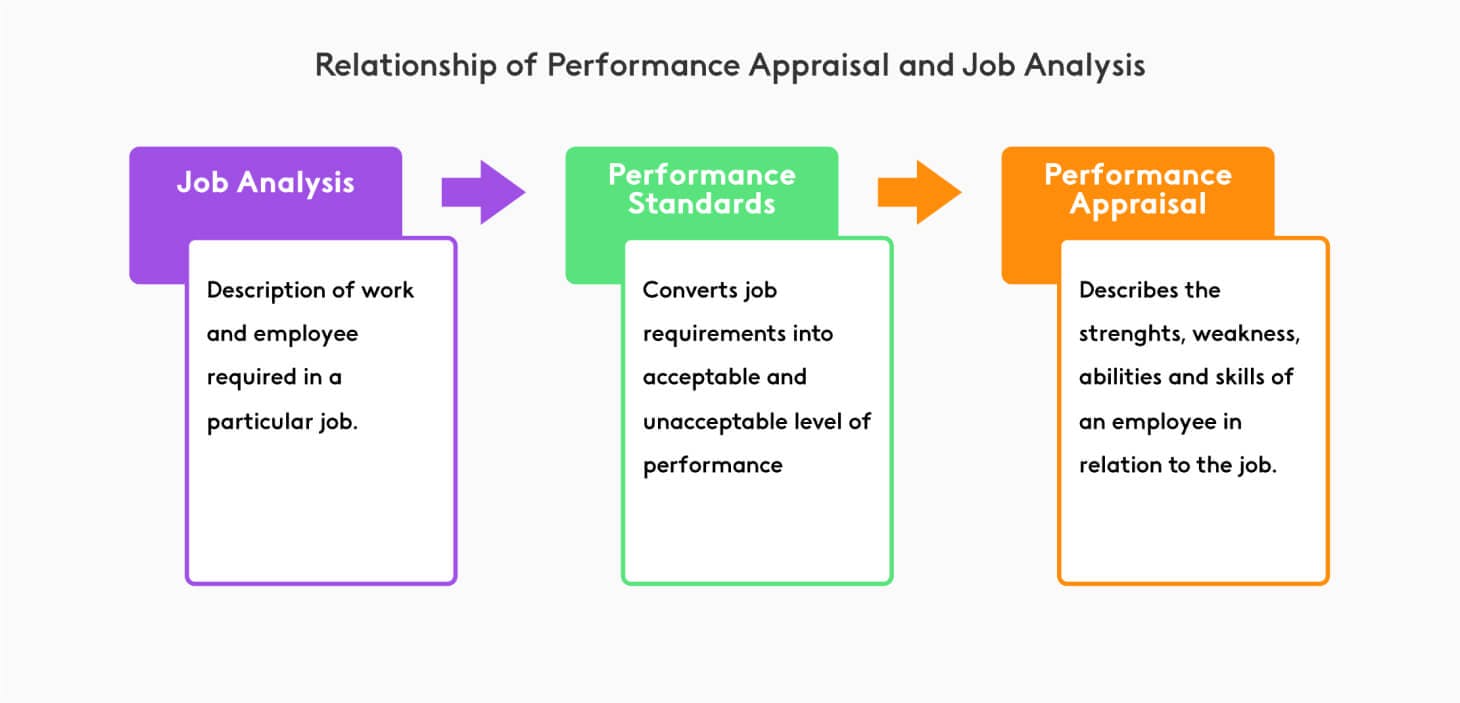
As we can see in the diagram above, performance reviews are linked to a work assessment to establish standards upon which employee performance is judged.
They are also different depending on the methods used. Employee appraisals are carried out using structured and formal processes while performance management pays closer attention to the company’s objectives.
You could say, therefore, that employee performance reviews are tasks that fall under a company’s performance management activities.
Advantages and disadvantages of appraisals
Like any process, performance appraisals have both advantages and disadvantages. The latter can often raise issues with employees, so it’s important to consider them and know how to spot them.
ADVANTAGES
Improve the organisation’s general performance.
Increase employee motivation.
Strengthen commitment to the company.
Helps you to spot internal talent.
Improves communication.
Helps to design career paths and growth.
Enables the development of compensation policies.
Helps to identify personal needs.
Facilitates decision-making about promotions and dismissals.
DISADVANTAGES
Requires the investment of time and resources.
Can create a tense atmosphere among employees.
Biases may occur, which renders the objectives of the appraisal invalid.
New methods of performance appraisals
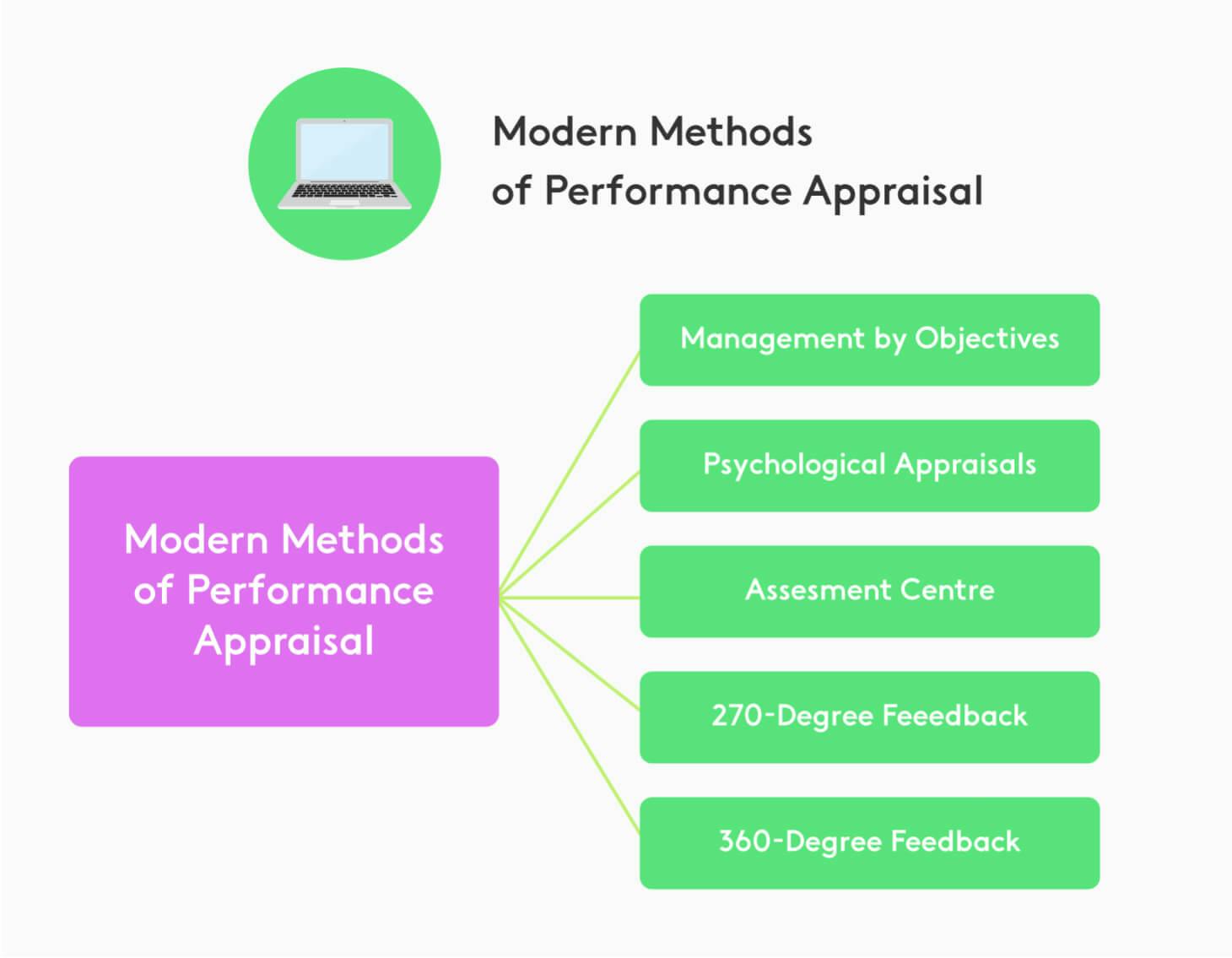
1. Management by objectives (MBO)
This appraisal method consists of identifying, planning, and defining objectives. After establishing clear objectives, both employer and employee should have regular meetings to analyse the progress made. The process is explained in this table:
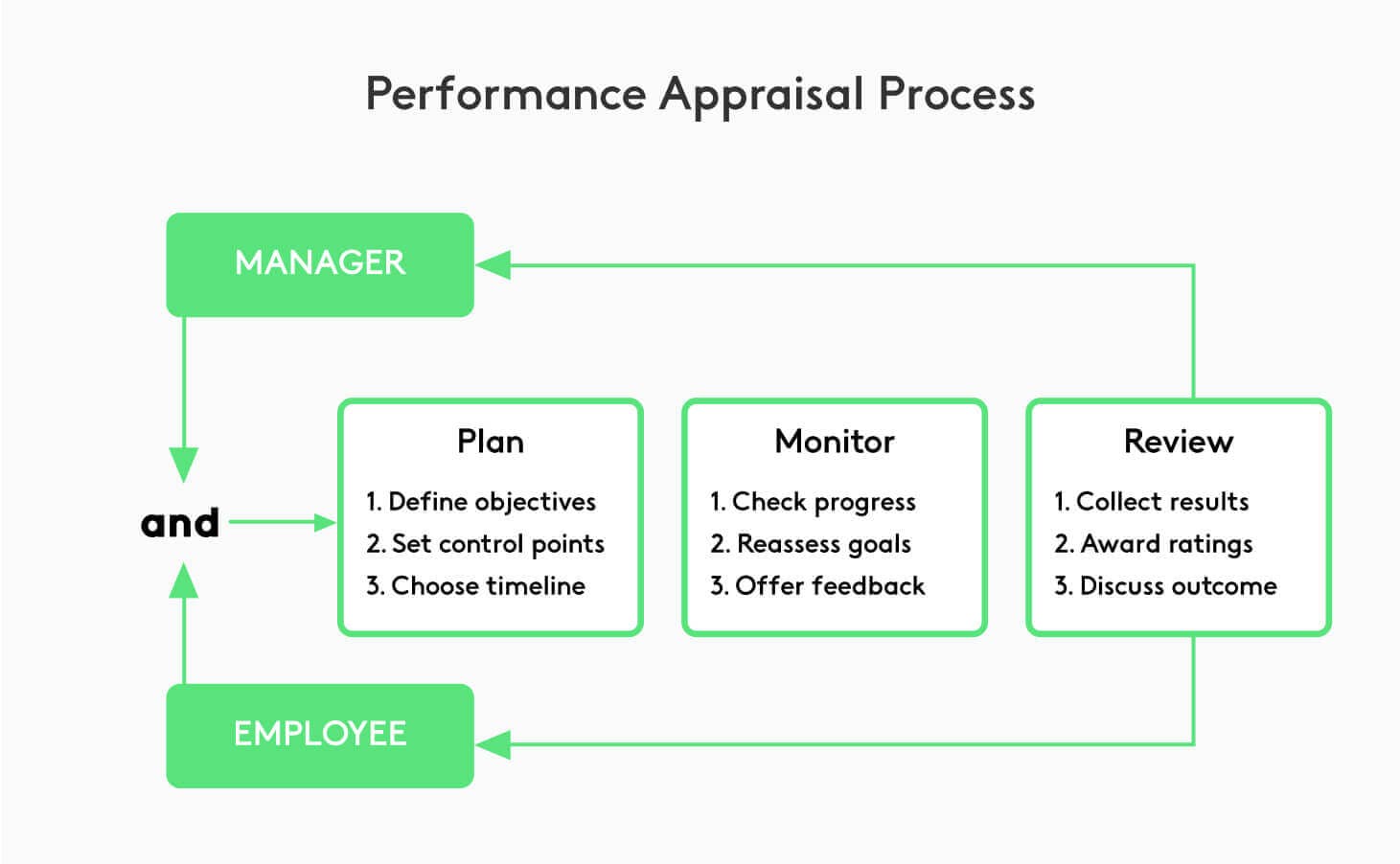
It’s essential that the objectives are linked to tangible and measurable tasks. A dashboard is one of the best ways to monitor this.
2. 180-degree performance appraisal method
The 180-degree performance appraisal is one where a professional is evaluated by their manager, their teammates and, where applicable, their clients. This method guarantees that we are collecting first-hand information (as it’s collected from people who work directly with the person assessed). It will provide us with a sufficient sample upon which to draw conclusions.
3. 360-degree performance appraisal method
The 360-degree performance appraisal method includes all of those who work with the employee: their superiors, clients, subordinates and even suppliers. In other words, it’s much more comprehensive and exhaustive than the 180-degree feedback method. It, therefore, gives a more complete picture of the employee’s performance.
This method will only be useful and serve its purpose if the risk of subjectivity is minimised with every reviewer and if it includes as many participants as possible.
It’s also important that each participant carries out their task:
Self-assessment
Every employee should do a self-assessment where they reflect on their performance, strengths and weaknesses. It’s vital that this is structured and follows a formal procedure to avoid biases and partial views.
Comments from line managers
Line managers normally take part in the appraisal process. Their comments should assess the employee’s overall work, and their participation in both their team and the company.
Performance reviews carried out by managers are part of the basic and traditional way of conducting appraisals. These reviews should include the individual employee rating given by supervisors, as well as the assessment from a team or programme done by senior managers.
Feedback from direct colleagues
Colleagues have a unique perspective of someone’s work and therefore become highly relevant. Their comments help to determine the employee’s ability to work in a team, take initiative, etc. Having said that, we also have to bear in mind that friendship of competitiveness can distort the results of appraisals.
Feedback from subordinates
Feedback from those who depend on the person being assessed is probably the most delicate of all, as they may be influenced by the fear of retaliation. It’s important that the process is always anonymous and to make sure that reviewers are aware of that.
Comments from clients
Clients included in the appraisal process could be internal, users of the product within the organisation, or external, who are not part of the company but who interact with the employee in question on a regular basis. Their comments can be used to assess someone’s skills but often do not take the influence of processes and internal politics into consideration.
4. Assessment centre or situational exercised method
This method assesses employees in a social situation to predict behaviour in specific situations. They are related to the activity the person performs within the company.
What does the assessment involve? The employee is asked to take part in situational exercises, workgroups or games in which they play a specific role. For example, they will be asked how they would solve a certain problem in the company to assess their problem-solving abilities, self-confidence, leadership skills, etc.
A study carried out by Richard Klimoski and Mary Brickner affirms that this method has a high rate of success for predicting abilities.
5. Behaviourally Anchored Rating Scale (BARS)
The Behaviourally Anchored Rating Scale (BARS) compares employee performance with specific examples of behaviour anchored to numerical ratings.
In other words, they will be presented with specific situations or behaviours and their performance will be rated as either high, moderate or low.
The objective of this method is to provide clear standards, accurately analyse performance and offer consistent assessments.
6. Psychological appraisals method
This kind of appraisal enables you to determine an employee’s hidden potential. To do this, the employee’s potential for future performance is assessed instead of their past work. How is this done? The assessment must be carried out by a psychologist to identify the individual’s emotional traits and intellect.
7. Human resources cost accounting method
Lastly, this model analyses the employee’s performance according to the revenue an organisation generates from their input. To calculate this, the cost the individual represents for the company is compared to revenue the employee generates.
Traditional methods of performance appraisal
As we were saying, we can also find traditional methods of performance review that are primarily based on the study of each employee’s personal qualities: knowledge, proactivity, loyalty, leadership and judgement.
DIFFERENT METHODS IN THIS CATEGORY
Ranking
The reviewer grades employees from best to worst to form a ranking. This is a comparative system and each employee’s position is determined by a numeric result.
Rating scales method
Used for assessing and rating predefined factors. This is done using a form which has tables with horizontal lines, showing the aspects under review, and columns with a rating scale.
Critical incidents method
This technique involves the investigation, observation and recording of an employee’s most outstanding traits while performing a specific task. The identification of critical incidents can be individual or between the employee and the reviewer.
Confidential report system
The reviewer writes a report about each employee’s strengths and weaknesses and adds suggestions for improvement. This technique focusses mainly on behaviour.

How to conduct a performance appraisal
As we can see, when we do a performance review it’s important to use a methodology but we must also follow a series of steps to ensure the validity of the process. You’ll find them here:
STEPS TO ENSURE THE VALIDITY OF THE PROCESS
Establish objectives: SMART objectives help us obtain personalised performance measurements for every member of the company. They must be: specific, measurable, attainable, relevant and timely.
Set clear expectations Dick Grote, author of the book How to be good at performance appraisals”, empathises the importance of internally communicating the objectives of the evaluation process, the procedure and consequences, etc. "Appraisals produce an immediate improvement in performance as all staff know what their manager expects of them", he explains.
Define the performance review indicators: as we’ll see later on, we should define the key metrics that will enable us to assess our employee’s work. We should use them to create a results dashboard for every employee.
Inform employees so that they can prepare for the appraisal: it’s essential that employees can prepare for the day by having done a self-assessment beforehand. They will be more relaxed as a result and take a more natural approach to the meeting.
Set a tone for the appraisal Grote recommends getting straight to the point and if the results are lower than expected, you should tackle the problem head-on. Otherwise, we are not giving the employee the opportunity to improve.
Ask the employee to share their self-assessment: as we mentioned earlier, the employee should be prepared for the appraisal and have done a self-assessment of their own work. This will help them to express themselves and carry out a personal evaluation of their work.
Use constructive criticism during the meeting: constructive criticism is important in bringing about change in an employee. This basically implies getting down to brass tacks and propose solutions for problems discussed. Instead of saying “you must be more proactive”, we could opt for: “You should take more initiative and call potential clients to generate more business.”
Manage the structure of the conversation: be sure to start off the conversation with the results obtained, giving the employee their chance to speak. Then move on to review objectives.
Conclude the meeting by setting out the next steps: the last step, and the most important of all, is to set new objectives for the employee and determine whether they need extra training to achieve them. Design a clear road map that both parties agree on.
Summarise the appraisal in writing: everything discussed in the meeting, as well as the next steps, should be put in writing and sent to the employee. It should also be stored for future consultation.
Skills to measure in a performance appraisal
Defining what to analyse or measure is key when planning a performance review. In other words, we need to decide what skills we should measure in a performance review for each professional profile in the organisation.
We can set out twelve generic abilities:
- Creativity and innovation: creativity is the ability to spot new opportunities, come up with original ideas, adapt to new situations and use the imagination to solve problems. Nowadays, this is one of the most valued skills. To measure this, we have to look at certain parameters: openness to experience, resilience, confidence, tolerance of ambiguity…
- Adaptability: another valuable characteristic in an employee is the ability to face new situations and approach them with a good attitude. A study by Barclays reveals that 60% of employers feel that this is one of the skills that has become more important in recent years.
- Communication: the ability to communicate, according to Barclays, is another skill that has become more important in recent times (according to 54% of those interviewed). Effective communication is fundamental to do a job well and preserve a good working atmosphere.
- Responsibility: accountability and taking responsibility for your actions is also a trait worth highlighting in an employee. Responsibility in the team context is crucial, otherwise difficult situations among team members will emerge.
- Attendance and punctuality: these two basic requirements are paramount for objective performance. Keeping track to ensure employees are complying with them is key for any assessment.
- Productivity and quality of work: productivity is one aspect that is usually of most interest to employees. We can measure this through different formulas, as we’ll see below.
- Achievements: recognition of achievements motivates employees and increases their commitment to the company. It’s important to go over the milestones reached and congratulate the employee for them.
- Cooperation: does the employee work well in a team? This aspect is key when it comes to maintaining a constant workflow and high levels of efficiency.
- Training: the employee’s eagerness to learn and grow professionally can be measured by how involved they get in training initiatives.
- Improvements: as mentioned earlier, it’s important to conclude by defining areas for improvement according to the employee’s weaknesses. This helps to boost employee growth and development as well as that of the company.
- Interpersonal skills: also known as soft skills, they concern how we communicate or relate to other people. These are becoming increasingly more influential in selection processes and appraisal processes.
- Problem-solving skills: the ability to detect issues, establish the cause and identify possible solutions. It’s important to see how the employee approaches different challenges and measure this ability during the performance review.
Metrics you should measure in performance appraisals
Rating scales are used in appraisals to obtain a quantitative measurement of employee performance. This system enables you to make simpler comparisons and accelerate the process and, therefore, gather the opinions of other reviewers.
We look at some of these scales below that can help you create your performance review.
1. Likert scale
The Likert scale is one of the most common and is mainly used to measure attitudes and gauge the extent to which an employee agrees with any of the assertions we make.

This scale should essentially be symmetrical, or rather, it should have an equal number of positive and negative answers.
The most common type of scale used has five options, but any number is acceptable. If it has an odd number, the central option will usually be the most neutral. If the number is even, it is sometimes referred to as “forced choice”, as it doesn’t provide the opportunity to choose an intermediate response.
The following example has three responses, and is also very common:
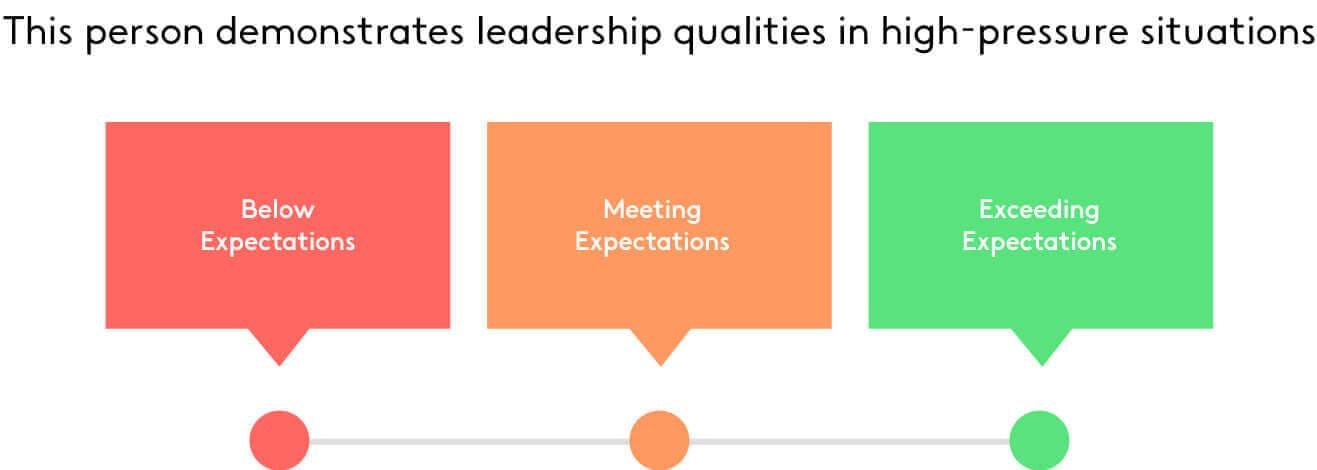
2. Semantic differential scale
The semantic differential scale presents two options on opposite ends of the scale. The reviewer marks their answer in the space between these two extremes - which contain up to seven empty spaces - placing it closer to one end of the scale or the other.

3. Personalised scale
Finally, another popular option for appraisals is to create a personalised scale and adapt it to the company’s needs. In this case, the human resources department itself creates its own method of answers and measurement. This gives you more flexibility, but extra care needs to be taken to ensure that the scale is fair and equitable.
How can you measure performance appraisals?
There are many ways to measure performance in appraisals. Many companies use dashboards that contain certain performance indicators and others are ruled by other criteria. The important thing is that each one is adapted to the company’s needs.
Now we’re going to take a look at the measurement model proposed by two experts: Milan Fekete and Igor Rozenberf of Comenius University and Seattle University, respectively.
1. Evaluate
Four main criteria are taken into account when evaluating performance:
- Individual performance.
- Skills, attitude and behaviour.
- Experience in the job.
- General work carried out.
Each of these four criteria carries a certain weight towards the total score the employee receives. This table shows the criteria proposed by two experts:
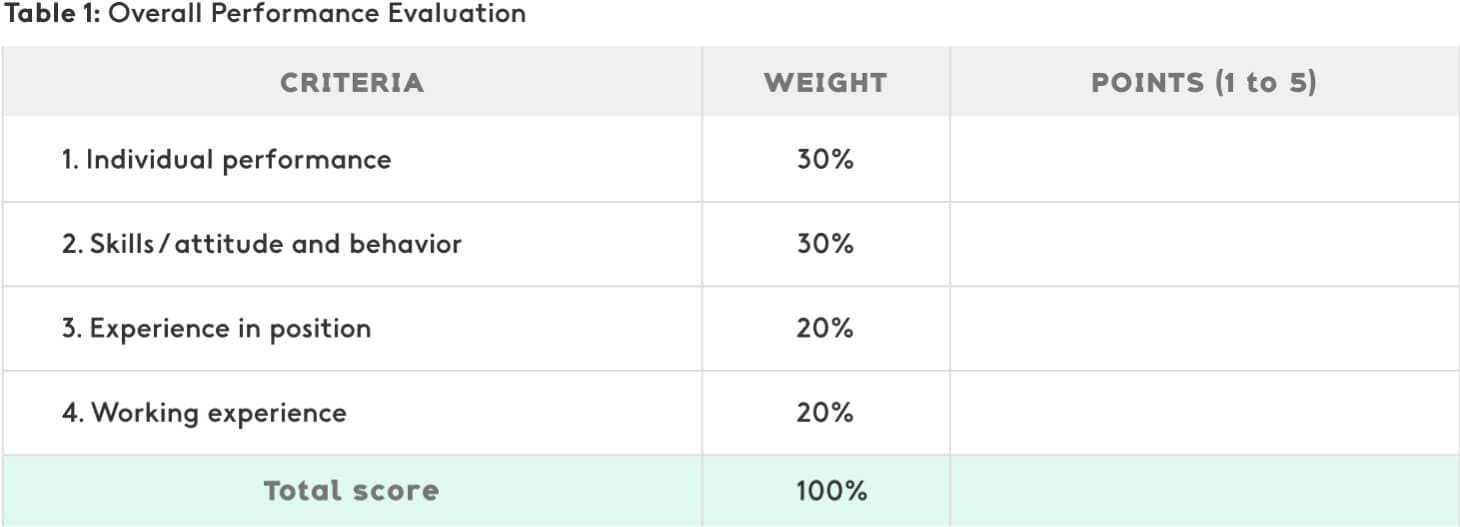
2. Measure the final results
How do we score each criterion? Each employee can be scored from 1 to 5. This table describes what each value means:

Professional skills can be divided into four areas:
- Understanding of the business and company strategy.
- Results obtained.
- Motivation.
- Training.
A point-based system is also recommended to rate experience in the job and the general work undertaken:
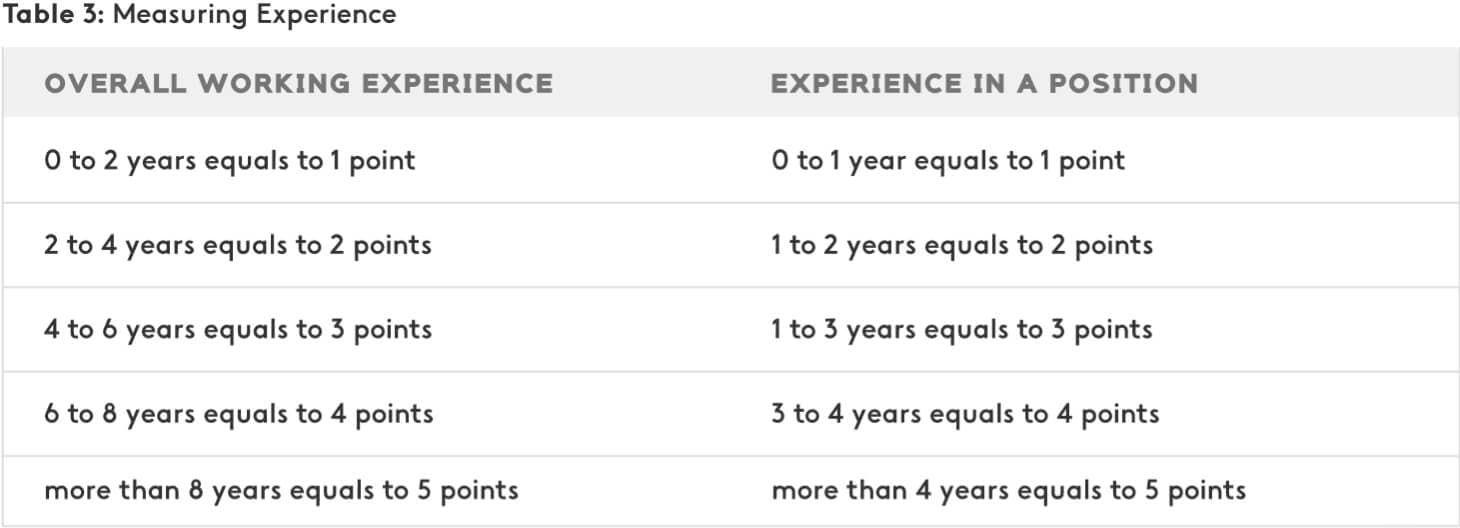
Once we have assessed each of the four areas and taken their respective weight into account, the employee will be given a final score. Here is an example:
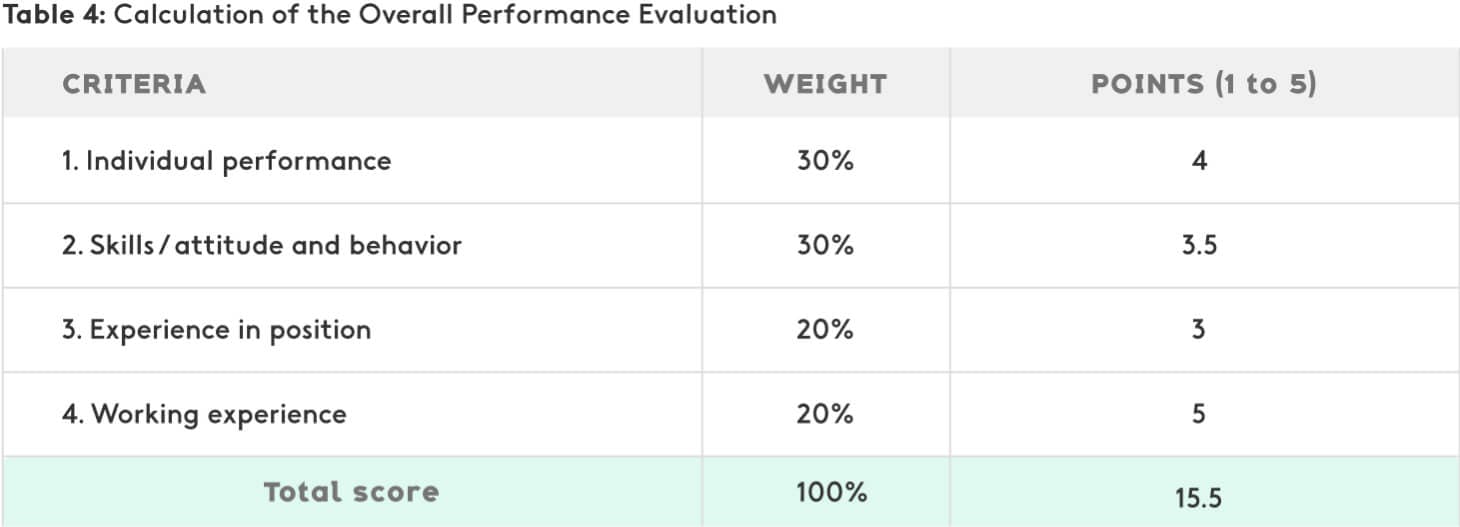
We can categorise the employee within a performance group according to the result:


3. Take action based on results
The result obtained in the evaluation could be linked to financial compensation, promotion or dismissal, changes of job position, etc. The company should establish its own scales and clearly communicate what could happen in each case.
Performance appraisal questions to ask
Once we have defined which skills we’re going to assess, the measurement scale, etc., we then need to prepare a list of performance appraisal questions to ask for the meeting. Choose these carefully because each one provides different information.
10 KEY QUESTIONS
Is there anything you’d like to say before we begin? Start the session by giving the employee the opportunity to express their opinion if they wish.
What has been your greatest achievement during this period? Start by giving the employee the chance to talk about their successes and gain self-confidence for the appraisal.
What do you think your biggest challenge will be for the next year? Their response will demonstrate their awareness of both their environment and the challenges the company faces.
Do you feel your personal objectives are aligned with those of the company? This question enables you to gauge whether the employee feels connected to the company.
What is the next role you’d like to take up in the company? This is a way of discovering their personal objectives, aspirations and obtaining information to help them with their goals.
In which areas do you feel you need to improve? The objective here is to see whether the employee is aware of their own limitations.
Which of your abilities make you more efficient and effective at your job? This question enables you to understand if the professional is a good fit for their current job.
What obstacles hinder you from achieving your goals? This gives the employee the chance to talk about potential improvements or weaknesses they detect within the company.
Do you have the tools and resources you need to do your job? Here the employee could talk about how they could improve their productivity and therefore benefit the company.
Is there anything else you’d like to add? Once again, finalise the session by giving the employee the opportunity to comment on or qualify any points they wish.
Which performance appraisal software tools should you use?
Nowadays, the most popular tool used for conducting performance reviews by most human resources departments is a fairly complicated excel template. Thanks to technology, however, we can find performance review software that is specifically designed to make the whole process much easier and faster.
A performance appraisal software enables you to track feedback processes more thoroughly and store all the information gathered in one platform. Likewise, they also enable you to work with pre-designed templates to lighten your workload.
How often should you conduct performance appraisals?
Appraisals are traditionally carried out annually in most companies, in accordance with their financial year. Even so, today’s performance management cycles tend to be six-monthly and even quarterly (especially in the case of new recruits in their first year).
These consist of two phases:
- Setting expectations.
- The performance review in relation to the expectations defined.
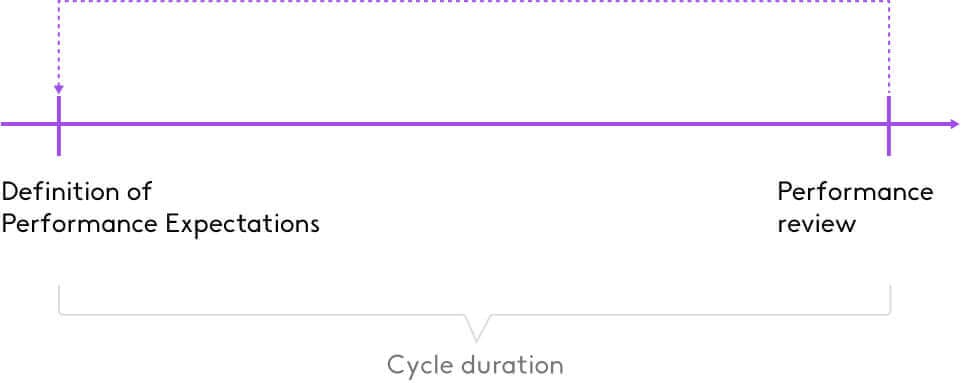
Frequency can, therefore, depend on the company’s own cycles. For example, if staff are evaluated on the basis of production, the usual production cycle is 80 days, so the appraisal cycle would adjust to this period.
Another factor to take into consideration is the time needed to implement the improvements proposed in previous appraisals. Three months may not be enough time for the employee to work on their weaknesses.
Ultimately, it’s the company who has to set its evaluation needs. Some may establish simpler periods and others may need to carry out more ongoing and thorough reviews.
New trends in performance appraisals
New performance review trends are based on data analysis, ongoing reviews and the use of technology as a fundamental tool.
Alejandro Ferraro, Executive HR Director of Accenture Latam, touches on this in an interview (in Spanish):
"We used to focus on meeting objectives, and we spent hours on peer comparison processes. We re now instead focussing on individual coaching, giving feedback throughout the year, working on skills development, on employee interests, on strengths, and on finding the best place for each collaborator where they give their all."
Appraisals, now more than ever, focus on people and helping them reach their objectives within the company and grow professionally. It’s a win-win for both sides. The objective is to stimulate a working culture based on merit and open spaces where there is a constant flow of feedback, even if it is informal.
KEY POINTS OF THE NEW TENDENCIES
Coaching is gaining more importance in boosting individual development.
Soft skills gain significance: teamwork, learning, culture...
Transparency is becoming a key value.
Feedback must be specific, personalised and have a purpose.
